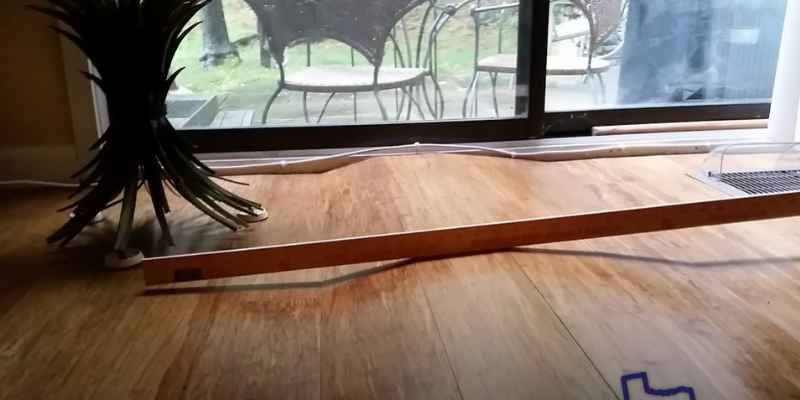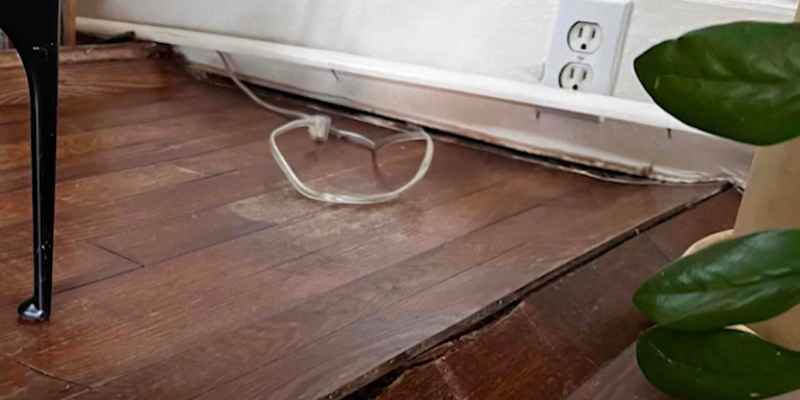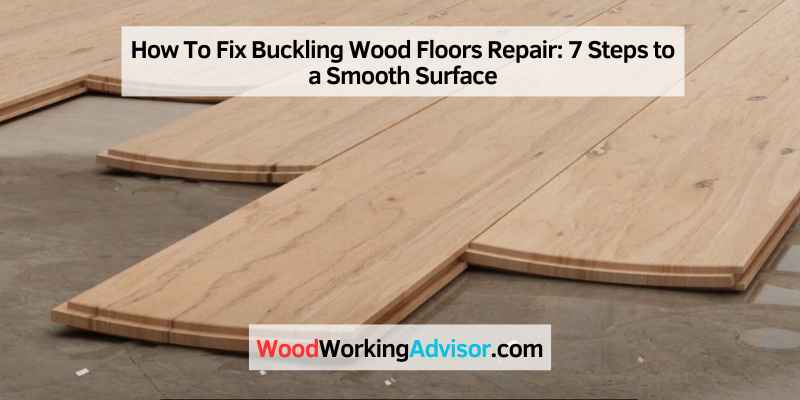To fix buckling wood floors, you need to identify the cause of the problem and address it. Start by determining if the issue is due to moisture, improper installation, or structural problems.
Once you have identified the cause, you can take appropriate steps to repair the buckling, such as addressing the moisture issue, correcting the installation, or making necessary structural repairs. Buckling wood floors can be a frustrating problem that not only affects the aesthetic appeal of your home but also poses risks to the structural integrity of your flooring.
Whether it’s caused by excessive moisture, improper installation, or structural issues, it’s crucial to fix this problem promptly to prevent further damage. We will explore some effective methods to repair buckling wood floors, helping you restore the beauty and stability of your flooring. By properly identifying the underlying cause and taking the necessary steps, you can ensure a long-lasting and sturdy wood floor in your home.
Common Causes Of Buckling Wood Floors
If you have noticed a buckling or warping in your wood floors, it is important to understand the common causes so you can effectively address the issue. Buckling wood floors not only detract from the beauty of your home, but they can also indicate underlying problems that need to be resolved. In this article, we will explore three common causes of buckling wood floors: moisture damage, excessive heat or humidity, and improper installation.
Moisture Damage
Moisture damage is one of the leading causes of buckling wood floors. When excess moisture comes into contact with the wood, it can cause the floorboards to expand and warp. This moisture can come from various sources, such as plumbing leaks, improper subfloor ventilation, or inadequate moisture barriers.
To identify moisture damage, look for signs like cupping or crowning of the floorboards. Cupping occurs when the edges of the boards are higher than the center, creating a concave shape. Crowning, on the other hand, is the opposite, with the center of the board being higher than the edges.
To fix moisture damage, it is crucial to address the source of the moisture first. This may involve fixing any leaks or improving subfloor ventilation. Once the moisture issue has been resolved, the affected floorboards may need to be dried and possibly replaced.
Excessive Heat Or Humidity
Excessive heat or humidity can also cause wood floors to buckle. Elevated temperatures can lead to the expansion of the floorboards, while high humidity levels can increase the moisture content in the wood, causing it to swell. This expansion and swelling can result in buckling.
If you suspect excessive heat or humidity as the cause of your buckling wood floors, it is essential to regulate the temperature and humidity levels in your home. This can be done through proper insulation, adequate ventilation, and the use of dehumidifiers or air conditioning units.
Improper Installation
Improper installation is another significant factor that can cause wood floors to buckle. If the floorboards were not installed correctly, without sufficient expansion gaps or a proper moisture barrier, the wood may not have the necessary flexibility to accommodate changes in moisture content or temperature.
If you suspect improper installation, it is best to consult a professional to assess the situation and determine the appropriate course of action. This may involve removing and reinstalling the affected floorboards or implementing remedial measures to alleviate the buckling.

Identifying Buckling Wood Floors
Identifying buckling wood floors is crucial for effective repair. Learn how to fix this issue and restore the stability and aesthetic appeal of your wooden floors.
Visible Buckling Or Warping
If you notice your wood floor looking uneven or bulging in certain areas, it is a clear sign of visible buckling or warping. This occurs when the wood boards expand and push against each other due to excessive moisture. As a result, the floor starts to lift and create an uneven surface. It is essential to address this issue promptly to prevent further damage and ensure the longevity of your wood floor.
Squeaky Or Loose Boards
Another indicator of buckling wood floors is the presence of squeaky or loose boards. When the wood absorbs excessive moisture, it swells and can cause the boards to separate or loosen. As a result, you may hear squeaking noises when walking on the affected area. This not only affects the aesthetics of your floor but can also be a safety hazard. Therefore, it is crucial to address this issue as soon as possible to maintain a sturdy and secure wood floor.
Moisture Or Mold
Excess moisture can lead to the growth of mold or mildew on your wood floor. If you notice any moldy or musty odors, it is a clear indication of moisture-related issues. Mold not only damages the wood but can also pose health risks to you and your family. Therefore, it is important to identify the source of moisture and take immediate action to prevent further damage and ensure the longevity of your wood floor.
In conclusion, identifying buckling wood floors is crucial for their timely repair. Visible buckling or warping, squeaky or loose boards, and the presence of moisture or mold are telling signs of underlying issues. By addressing these issues promptly, you can extend the lifespan of your wood floor and maintain its beauty and functionality.
Gathering The Necessary Tools And Materials
When it comes to repairing buckling wood floors, it’s important to gather the necessary tools and materials. Having the right equipment at your disposal will ensure a smooth and efficient repair process. Here are the key items you’ll need:
Hammer
A hammer is an essential tool for any DIY enthusiast. Make sure you have a sturdy and reliable hammer to help you with your wood floor repair. This versatile tool will come in handy when you need to drive nails or gently tap boards back into place.
Circular Saw
A circular saw is a valuable tool for cutting through the damaged or buckling floorboards. With its precision and power, you’ll be able to remove the affected sections with ease. Ensure your circular saw is in good condition and equipped with a suitable blade for cutting wood.
Wood Glue
Wood glue is an essential adhesive that will help you reattach loose or damaged floorboards. Look for a high-quality wood glue that dries quickly and provides a strong bond. Applying glue will reinforce the stability of your repaired floor, making it resistant to future issues.
Moisture Barrier
A moisture barrier is crucial for preventing future buckling of your wood floors. It acts as a protective layer against moisture, which can cause wood to expand and contract. Choose a moisture barrier that is appropriate for your specific flooring type and install it correctly to prevent any future issues.
Flooring Nails
Flooring nails are necessary for securing loose floorboards and preventing further buckling. Ensure you have an adequate supply of nails that are designed specifically for flooring installation. These nails are usually longer and sturdier than standard nails, allowing them to hold the boards securely in place.
By gathering these essential tools and materials, you’ll be well-prepared to tackle the task of fixing buckling wood floors. Remember to follow the manufacturer’s instructions and take necessary safety precautions when using power tools. With the right equipment and a step-by-step approach, you can restore the beauty and functionality of your wood floors in no time.
Seven Steps To Fix Buckling Wood Floors
Dealing with buckling wood floors can be a frustrating and unsightly problem. However, with the right steps, you can repair and restore your floors to their former glory. In this article, we will guide you through seven essential steps to fix buckling wood floors, ensuring a successful and lasting repair.
Assess The Extent Of The Damage
The first step in fixing buckling wood floors is to assess the extent of the damage. Walk around the affected area, inspecting the floorboards carefully. Look for any signs of moisture, warping, or gaps between the boards. This assessment will help you determine the appropriate course of action for repairing the problem.
Dry The Affected Area
Once you have identified the buckling wood floorboards, it is crucial to dry the affected area thoroughly. Use fans, dehumidifiers, or natural ventilation to remove any excess moisture. This step is essential to prevent further damage and ensure a successful repair.
Remove The Damaged Boards
To fix buckling wood floors, you must remove the damaged boards. Carefully pry them up using a crowbar or chisel, being mindful not to damage the surrounding boards. If the buckling is more severe, you may need to remove multiple boards to access the underlying subfloor.
Repair Or Replace Subfloor If Necessary
After removing the damaged boards, assess the condition of the subfloor. If it is wet, damaged, or uneven, it will need to be repaired or replaced. Addressing the underlying cause of the buckling is crucial to prevent future issues and ensure the stability of your wood floor.
Reinstall The Boards
Once the subfloor is repaired (if necessary), it’s time to reinstall the boards. Begin by carefully aligning the replacement boards with the existing ones, ensuring a seamless transition. Use a hammer and finishing nails to secure the boards firmly, making sure they are level and flush with the surrounding floor.
Sand And Refinish The Floor
With the boards securely in place, the next step is to sand the entire floor. This process removes any imperfections and creates a smooth, even surface. Start with a coarse sandpaper and gradually work your way up to a finer grit until the wood feels smooth to the touch.
Apply Protective Finish
Finally, to protect your newly repaired wood floor, apply a protective finish. Choose a suitable finish that matches the aesthetic you desire. Apply the finish evenly using a brush, roller, or sprayer, following the manufacturer’s instructions. Allow sufficient drying time before moving furniture or heavy objects back onto the floor.
By following these seven steps, you can effectively fix buckling wood floors and restore the beauty and functionality of your space. Remember to be patient and meticulous throughout the process, ensuring a long-lasting and durable repair.

Preventative Measures To Avoid Buckling Wood Floors
Proper maintenance and adherence to preventative measures play a crucial role in avoiding the frustrating problem of buckling wood floors. By taking proactive steps to control moisture levels, using proper floor installation techniques, and conducting regular maintenance and inspections, you can help ensure the longevity and durability of your wooden flooring.
Control Moisture Levels
One of the primary causes of buckling wood floors is excessive moisture. To prevent this, it is vital to control the moisture levels within your home or office. Here are some tips to help you:
- Ensure that the subfloor is moisture-free and properly sealed before installing the wood floor.
- Avoid installing wood flooring in high-moisture areas, such as bathrooms or basements.
- Consider using a dehumidifier in places with high humidity.
- Wipe up any spills or moisture on the floor immediately to prevent it from seeping into the wood.
Use Proper Floor Installation Techniques
Inadequate installation can lead to buckling wood floors down the line. To avoid this issue, follow these essential installation techniques:
- Acclimate the wood flooring in the room it will be installed for at least 72 hours.
- Use a moisture barrier, such as a vapor retarder, to prevent moisture from the subfloor reaching the wood flooring.
- Follow the manufacturer’s instructions and guidelines for proper installation practices.
- Ensure sufficient expansion gaps around the perimeter of the room to allow for wood movement.
Regular Maintenance And Inspections
Regular maintenance and inspections are crucial to identify and address potential issues before they develop into significant problems. Here are some tips for maintaining your wood floors:
- Sweep or vacuum the floor regularly to remove dirt and debris that can cause scratches or wear on the surface.
- Avoid using excessive water when cleaning the floor; instead, use a damp mop with a mild wood floor cleaner.
- Periodically check for signs of moisture, such as cupping or warping, and address any issues promptly.
- Consider using area rugs or mats in high-traffic areas to minimize wear and tear.
By implementing these preventative measures, you can significantly reduce the risk of buckling wood floors and enjoy the beauty and durability of your wooden flooring for years to come.
Conclusion
Addressing buckling wood floors requires quick action and a careful approach. By identifying the underlying cause and implementing the appropriate repair techniques, you can restore your floors to their former beauty and prevent further damage. Whether it’s acclimating the wood, fixing moisture problems, or consulting a professional, prioritizing the health and stability of your wood floors is essential for a long-lasting and visually appealing home.
So don’t wait, take action and enjoy the results of your efforts.

